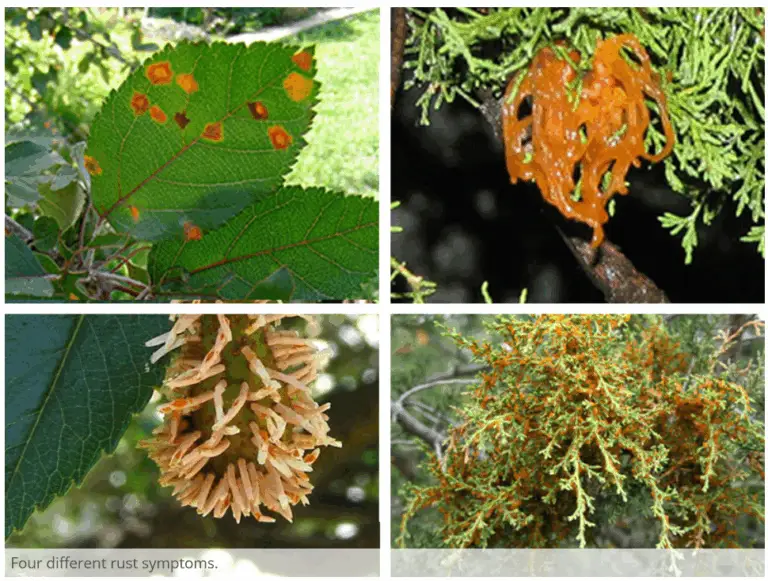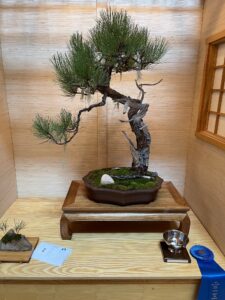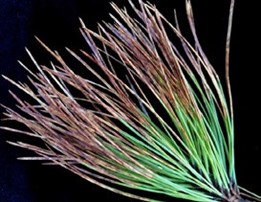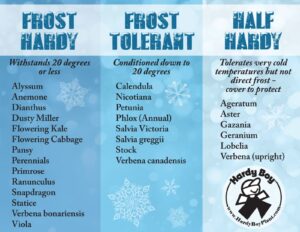
Cedar-apple rust is a common plant disease caused by the fungal pathogen Gymnosporangium juniperi-virginianae. It infects members of the Rosaceae and Cupressaceae families, primarily apple, crabapple, eastern redcedar, and other juniper species. Cedar-apple rust is a widespread disease across the continental U.S. and is a common issue for apple producers due to the prevalence of redcedar and juniper as ornamental plants in landscapes. Although cedar-apple rust is typically a non-injurious disease on redcedar and juniper, the symptoms can be significant and damaging on apple.
Symptoms and Signs
Primary host – redcedar/juniper
Symptoms of the infection appear in early summer, following infection by the pathogen the previous summer, when galls begin to form on the branches of the primary host. The galls first appear as small green or brown-colored swollen areas on the sections of the branch where needle-like leaves are growing. Eventually, these galls grow and become dark brown with a diameter of up to two inches. The galls, which are not always spherical and can have lumpy areas, always have small circular dimples across the surface.
When spring approaches and rainfall increases, large, gelatinous protrusions will erupt from the dimples along the surface of the gall. The protrusions are typically bright orange, but the amount of orange pigmentation can vary. These are called telial horns, and are spore producing structures of the pathogen, making them the first sign of a fungal fruiting body post-infection. They can dry out with lack of rain and re-swell many times throughout the spring. After the telial horns release their spores and dry up, the gall will die and may stay on the branch for a year or more. These galls sometimes lead to branch or twig death (e.g., produce tip blight and branch dieback symptoms) where they grow, but no other symptoms or signs are evident on juniper or redcedar.
Alternate host – apple/crabapple
Initial symptoms of fungal infection appear on apple and crabapple plants as small chlorotic (yellow) spots, which eventually become orange and develop red rings around the edge. Small, orange or dark-colored, sporulating pustules (spermogonia), develop on these lesions on the upper side of the leaf. A little later, fungal fruiting bodies, called aecia, appear on the underside of the leaf and eventually develop hairy, tube-like growths. The aecia will become evident as relatively thick protrusions on the leaf lesion surface. Extensive infections may cause the plant to drop leaves, severely impacting the plant’s photosynthetic ability. On the pome fruits, symptoms begin as small yellow or orange lesions, which eventually grow larger and turn brown. Fruit lesions can also develop tube-like aecia, sometimes in large quantities. On crabapple this gives the little fruits a spiky appearance. These lesions may cause the fruit to crack open and the fruit stem may become infected causing early stunting in fruit development (Villani, 2018).
Source Ohio State University
I have found that the protrusions seem to form on newly collected trees or trees that have been repotted. They also seem to form during our damp spring weather, but this may also be when they are the most visible. I have junipers, cedar, and crab apple bonsai, and have my own apple orchard and have several apple orchards near me. If you have neighbors with apple trees and or crab apples within several miles, it is only a matter of time before you may experience cedar-apple rust.
Treatment:
One option is to not have any cedar or juniper bonsai, to me this is not an option.
My own personal experience is that by daily observations and cutting out any infected area when first noticed. I also treat all my trees with the systemic fungicide that BC sells and I have not experienced another outbreak for two years.
Prevention:
Good bonsai pruning allows airflow and allows foliage to quickly dry out. Try to plan out your location of species to limit airflow from the direction of known apple or crab apple trees. If possible quarantine any new trees until you are sure they are not harboring any diseases. Lastly, I recommend the use of systemic fungicide on our bonsai trees.




